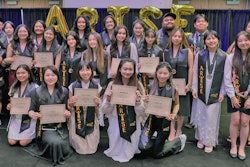Investigating Newsroom Diversity
Can daily newspapers deliver on minority recruitment and retention?
By Ronald Roach
As with many minority journalists, Lynne Varner, an editorial writer for The Seattle Times, has long demonstrated a commitment to attracting and recruiting Black, Latino, Asian American and American Indian students to the journalism profession. That interest has prompted Varner to help coordinate high school journalism workshops and mentor journalism students and reporting interns who are in college. Yet in stark contrast, the commitment shown by her newspaper employers to cultivate and promote Varner in the newsroom has proven disappointing to her over the course of 14 years in the news profession.
“I had to announce my resignation from (The Seattle Times) before they agreed to promote me into my current position,” Varner says.
While the recruitment of minorities into college and university journalism programs and into newspaper jobs is seen as a high priority in the newspaper industry, minority journalists are at odds with their employers over their failure to nurture and promote minorities in the newsroom. The inability to secure timely promotions and getting overlooked for prestigious assignments are common complaints uttered by minority journalists.
“The question we have on the table is why are (minority journalists) leaving the profession at a disproportionate rate than non-minorities,” says Wanda Lloyd, executive director of the Freedom Forum Institute for Newsroom Diversity. The Freedom Forum is an international foundation committed to free speech and a free press that supports American newsroom diversity as one of its goals.
The retention issue surfaced decisively earlier this year when the American Society of Newspaper Editors (ASNE) released data showing that the number of minority journalists fell for the first time since ASNE started tracking daily newspaper staffing figures in 1978. The ASNE survey revealed that the portion of African American journalists at daily newspapers also declined.
“The newspaper industry took in about 600 journalists of color in 2000 and watched 698 leave. More shocking is that the percentage of African Americans dropped from 5.31 percent in 2000 to 5.23 percent in 2001,” declared Will Sutton, the outgoing president of the National Association of Black Journalists (NABJ), to ASNE members at the group’s April plenary meeting in Washington. “Folks, we’re going the wrong way.”
According to the ASNE census, more full-time professional journalists of color were hired in 2000 than in any of the past 10 years, yet the proportion of non-White journalists fell from 11.85 percent to 11.64 percent in 2001. On the radio and television news side, minority journalists account for 22 percent of newsroom staffs, according to the Radio-Television News Directors Association (RTNDA).
Lloyd says the retention issue, like the recruitment and training of journalists of color, represents an issue needing high-level attention by the newspaper industry. The challenge for minority journalists, journalism educators and newspapers is to continue to increase recruitment and training programs while taking on minority retention in a serious way, according to Lloyd.
Reflecting
America’s Diversity?
For many, the decline in minority newspaper journalists comes at a difficult time given that ASNE officials revamped industrywide goals for minority representation in 1998. Originally in 1978, ASNE pledged that the nation’s daily newspapers would fully reflect American society’s racial and ethnic diversity by the year 2000.
In 1998, when it had become clear that the goal would not be met, ASNE changed its diversity mission statement to say that “the nation’s newsrooms must reflect the racial diversity of American society by 2025 or sooner.”
“This mission statement strongly reaffirms our commitment to having newsrooms that reflect the communities that we cover,” stated Edward Seaton, then-ASNE president, in 1998.
Among minority journalists, however, there had been a growing recognition that despite the establishment of admirable recruitment and training programs, both newspapers and broadcast news stations were failing to nurture and promote minorities at levels comparable to their White colleagues. In 1993, NABJ conducted a study titled “Muted Voices: Frustration and Fear in the Newsroom” that examined the attitudes of Black journalists and White news managers.
The study found Black journalists in broadcast and print to have starkly contrasting views to those of their White managers on issues relating to promotions and commitment to retention. According to the study, 67 percent of Black journalists said their managers were not committed to promoting and retaining Black journalists while 5 percent of the managers agreed. Ninety-two percent of the managers reported that standards for promotions were the same for Blacks and non-Blacks while only 28 percent of the Black journalists agreed they were the same.
“When ‘Muted Voices’ came out in 1993, it helped increase the dialogue about diversity in the newsroom,” says Lloyd, one of the study’s editors.
The decline in the African American and other minority presence at daily newspapers in 2001 represents for many an inevitable development. A number of Black journalists say it does not surprise them that ASNE would have to reset its minority representation goals given the professional roadblocks encountered by Black newspaper professionals and the ongoing need to increase minority recruitment.
“I didn’t have the numbers to back me before, but I knew that I was seeing a lot of disappointment among my colleagues by the way their companies were treating them,” says Varner of The Seattle Times.
Broadcast vs. Print
Minority representation in radio and television newsrooms has outpaced that of daily newspapers, but still lags proportionately to overall diversity in American society. Condace Pressley, an Atlanta-based radio news producer and the outgoing NABJ vice president for broadcast, says the pipeline for minority radio and television journalists has not traditionally lacked for eager candidates.
“There’s no shortage of people of color who want to be on TV and in radio,” Pressley says.
In addition to having plenty of eager job candidates, radio and television news stations have been subject to affirmative action hiring guidelines unlike newspaper companies and other print publications.
While non-White radio and TV journalists comprise 22 percent of radio and TV news staffs, minorities are estimated to be 30 percent of the American population. Pressley says retention of minority journalists is a problem in radio and television news, especially among minority news managers.
In the 1999 RTNDA/Ball State Annual Survey, the number of minority news directors in both television and radio decreased from the previous year’s gains to the levels held in 1997. Television representation fell two points to 8 percent, and radio dropped three points to 8 percent. In both radio and TV, most of the decrease involved Black news directors, according to NABJ.
“There has been great consolidation in the industry,” Pressley says.
The consolidations, most notable in the radio industry, have led to downsizings and eliminations of news operations, she added.
Most recently, the RTNDA reaffirmed “its commitment to diversity in hiring practices in light of the recent action by the FCC to suspend the EEO (Equal Employment Opportunity) rules that once governed newsrooms.” The RTNDA board, in March, approved a measure reiterating its support of diversity principles, originally passed in 1998.
More Industry
Support Urged
The recognition by news media industry officials that current efforts to diversify newsrooms are falling short is fueling some candid thinking on the part of industry and foundation officials.
ASNE has estimated that for daily newspapers to achieve racial and ethnic newsroom representation that matches the diversity in American society, which will be nearly 38.2 percent non-White in 2025, 625 journalists of color in addition to the current average of 550 must join newspapers annually. This total exceeds the cohort of minority students in college print journalism programs.
“We must look in new places, beyond journalism schools. The 20th century pool of minority candidates is too shallow. We don’t need a pool. We need a lake. We need an ocean. We need to redefine how we attract and retain qualified minority journalists to newspapers,” stated Charles L. Overby, chairman and chief executive officer of the Freedom Forum, during a recent speech titled “Race Relations and the Media in the 21st Century,” which was televised on C-SPAN.
In recent years, newspaper companies and foundations have begun investing in recruitment and training programs, such as high school journalism workshops for minority students and minority recruitment efforts at journalism schools. Yet in dealing with specific issues, such as retention at small daily newspapers, newer style programs are beginning to emerge. For instance, one recent program sponsored by the Freedom Forum, ASNE and the Associated Press Managing Editors organization awards minority journalists at newspapers with less than 75,000 circulation a $10,000 annual salary supplement for remaining at the publication for up to two years.
As executive director of the Freedom Forum Institute for Newsroom Diversity, Lloyd is presiding over the establishment of a training program designed to bring people into the profession who are well educated, working adults and who live in communities where newspapers are eager to attract minority journalists. In Nashville, Tenn., a newly constructed building on the campus of Vanderbilt University will house the Freedom Forum Institute for Newsroom Diversity this fall. The new training program will begin in January 2002, according to Lloyd.
The participants will be nominated by their local newspapers, which are responsible for hiring them after the training. Program participants will undergo 12 weeks of intensive journalism training that will ready them to fill reporting, editing and photography jobs upon their return home. Lloyd says the institute is expected to train 80 new newspaper journalists annually.
“We think these journalists will remain with their newspapers for a long time because they and their families will be settled in the communities where they’ll be working,” Lloyd says.
The program hopes to attract college-educated, public-minded professionals, such as teachers, police officers, social workers and retired military officers, according to Lloyd.
While Vanderbilt is home to the Freedom Forum’s First Amendment Center and the Institute for Newsroom Diversity, the university does not have a journalism program, Lloyd notes. Nearly all the instruction will come from hired newspaper veterans. A few Vanderbilt faculty members in specific subjects, such as law, will teach courses in the training program.
Tuition, housing and transportation costs are covered by the Freedom Forum, and students will receive a small stipend during their training.
“We believe there are hundreds, maybe thousands, of people of color who are working in other careers who would like to work for newspapers in their hometowns but are in other jobs,” says the Freedom Forum’s Overby.
Investing in HBCU
Journalism Programs
A growing emphasis by the news media industry to increase newsroom diversity is proving to have momentous benefits for at least two historically Black institutions — Florida A&M University and Hampton University.
Industry sponsorship — which has traditionally gone to the wealthiest and the most recognized journalism schools — is responsible for a new $5 million building opening at Hampton University this fall that will house the Virginia school’s department of mass media arts. At FAMU, school officials will break ground in the late fall to mark the construction of a $20 million building for the school of journalism, media and graphic arts.
Over the past year, the Scripps Howard Foundation, in a partnership with Hampton to increase diversity in newsrooms, has donated $5 million for the construction of a new journalism and communications center on the Hampton campus. The foundation, which is the philanthropic arm of the E.W. Scripps Company, has also committed $2.3 million over the next few years in support of the journalism program, scholarships and an endowed journalism professorship.
The E.W. Scripps Company, a media conglomerate based in Cincinnati, singled out the Hampton mass media program for revitalization after making the decision to invest in historically Black institutions “because of the important role they play in educating more than a third of this nation’s African American college graduates,” says Judith G. Clabes, president and CEO of the foundation. “Our search led us to Hampton,” she noted.
Charlotte Grimes, the chair of the mass media arts department, says that Hampton president Dr. William Harvey sought the partnership with the Scripps Howard foundation because he wants to turn the Hampton journalism program into one of the top programs in the nation.
“The goal is to make Hampton University’s journalism program one of the top 10 programs in the country and to create at Hampton University a role model for other historically Black institutions and potential media partners,” according to a statement by Harvey.
Grimes, a veteran newspaper reporter and editor, was hired by Hampton in 2000 to revamp and strengthen the journalism program. She currently holds the endowed Scripps Howard Professorship of Journalism. The funding also has established the Scripps Howard Visiting Professional program.
“This is a major step in a better direction to rebuild the journalism program in a way that will boost diversity (in newsrooms),” Grimes says.
At FAMU, the John S. and James L. Knight Foundation has committed millions with the aim of improving journalism and media education at the nation’s largest historically Black public university. Robert M. Ruggles, dean of FAMU’s school of journalism, media and graphic arts, says the Knight foundation is contributing $3 million toward the construction of a new building for the school. The foundation has already helped establish an endowed professorship, a faculty and student support endowment, and a student scholarship program, according to Ruggles.
“Knight has done a great deal for us,” Ruggles says.
Ruggles says it’s critical that historically Black schools position their journalism programs for news industry assistance.
“I’d like to see more involvement (by the news industry). We need the money, particularly at HBCUs since we’ve been so chronically underfunded,” Ruggles says.
The Knight foundation is recognized as one of the leading organizations devoted to the improvement of the media and journalism in American society. Ruggles credits the foundation for helping put FAMU on a footing that would have been unlikely without its support.
© Copyright 2005 by DiverseEducation.com



















